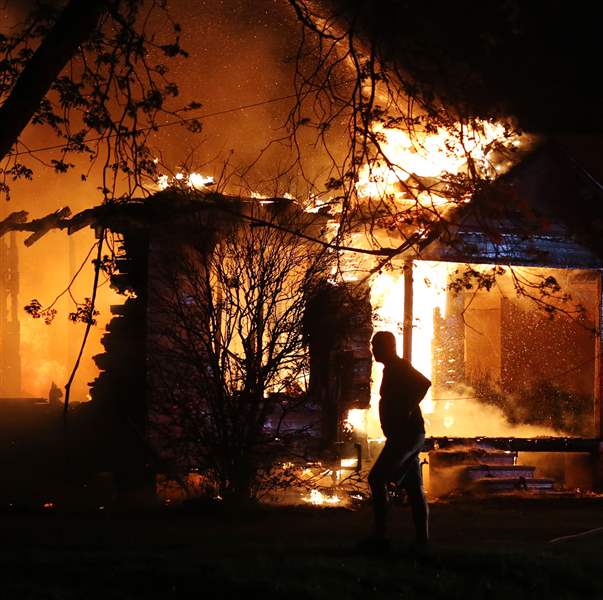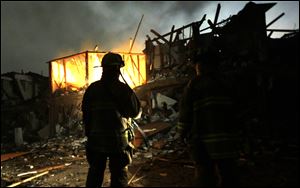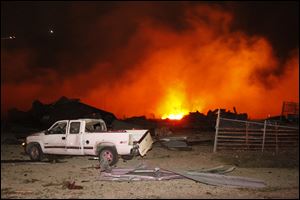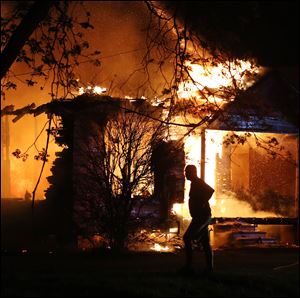
15 feared dead in Texas fertilizer plant explosion
Blast that was powerful enough to register as small earthquake
4/18/2013
A man looks on as emergency workers fight a house fire after a nearby fertilizer plant exploded Wednesday in West, Texas.
ASSOCIATED PRESS
WEST, Texas — Rescue workers searched the smoldering ruins of a fertilizer plant Thursday for survivors of a monstrous explosion that leveled homes and businesses in every direction across the Texas prairie. As many as 15 people were feared dead and more than 160 others injured.

Firefighters use flashlights to search a destroyed apartment complex near a fertilizer plant that exploded.
Daybreak revealed a breathtaking band of destruction extending outward from the West Fertilizer Co. in this small farming community about 20 miles north of Waco. The thunderous blast was so powerful that it shook the ground with the strength of a small earthquake and could be heard dozens of miles away.
Searchers “have not gotten to the point of no return where they don’t think that there’s anybody still alive,” Waco police Sgt. William Patrick Swanton said. He did not know how many people had been rescued.
PHOTO GALLERY: click here to view
RELATED CONTENT: Key facts about the Texas fertilizer plant explosion
VIDEO: see the moment of the blast, recorded by local man and his son, who are fine.
There was no indication the blast was anything other than an industrial accident, he said.
The explosion rained burning embers and debris down on terrified residents. It leveled a four-block area around the plant, badly damaging or destroying up to 75 houses, a 50-unit apartment complex, a middle school and a nursing home.
All that remained of one home was the fireplace and chimney. Several buildings with smashed roofs and leveled walls still were smoking Thursday morning.

The explosion at West Fertilizer could be heard as far away as 45 miles to the north. It sent flames shooting high into the night sky and rained burning embers, shrapnel and debris down on shocked and frightened residents.
Firm information was hard to come by in the hours after the blast, and entry into the town was slow-going as the roads were jammed with emergency vehicles. Authorities themselves had trouble entering the heart of the blast zone.
“It’s still too hot to get in there,” said Franceska Perot, a spokeswoman for the Bureau of Alcohol, Tobacco and Firearms.
Among those believed to be dead were three to five volunteer firefighters and a law enforcement officer. The many injuries included broken bones, bruises, lacerations, respiratory distress, and some head injuries and minor burns. Five people were reported in intensive care.
In the hours after the blast, residents wandered the dark, windy streets searching for shelter. Among them was Julie Zahirniako, who said she and her son, Anthony, had been at a school playground near the plant when the explosion hit.
The explosion threw her son four feet in the air, breaking his ribs. She said she saw people running from the nursing home, and the roof of the school lifted into the sky.
“Hit the ground, hit the ground,” Zahirniako heard a neighbor yell.
“The fire was so high,” she said. “It was just as loud as it could be. The ground and everything was shaking.”

A man looks on as emergency workers fight a house fire after a nearby fertilizer plant exploded Wednesday in West, Texas.
William Burch and his wife, a retired Air Force nurse, entered the damaged nursing home before first-responders arrived. They split up, searched separate wings and found residents in wheelchairs trapped in their rooms. The halls were dark, and the ceilings had collapsed. Water filled the hallways. Electrical wires hung eerily from the ceilings.
“They had Sheetrock that was on top of them. You had to remove that,” Burch said. It was “completely chaotic.”
Authorities said the plant made materials similar to those used in the 1995 Oklahoma City bombing.
West Mayor Tommy Muska told reporters that his city of about 2,800 people needs “your prayers.”
“We’ve got a lot of people who are hurt, and there’s a lot of people, I’m sure, who aren’t going to be here tomorrow,” Muska said. “We’re going to search for everybody. We’re going make sure everybody’s accounted for. That’s the most important thing right now.”
At the Hillcrest Baptist Medical Hospital in Waco, elderly people were wheeled in on stretchers. A man in a wheelchair with his T-shirt covered in blood winced as teams tended to his wounds.
About a half-hour before the blast, the town’s volunteer firefighters had responded to a call at the plant, Swanton said. They immediately realized the potential for disaster because of the plant’s chemical stockpile and began evacuating the area around the plant.
The blast happened 20 minutes later. Muska, who was among the firefighters, said it knocked off his fire helmet and blew out the doors and windows of his nearby home.
The main fire was under control late Wednesday, but residents were urged to remain indoors because of the threat of new explosions or leaks of ammonia from the plant.
Firefighters used flashlights to search the still-burning skeleton of an apartment complex that was all but destroyed. A flood-lit football field was initially used as a staging area, then other triage centers sprung up around the blast site.
First-responders evacuated 133 patients from the nursing home, some in wheelchairs. Many were dazed and panicked and did not know what happened.
Erick Perez was playing basketball at a nearby school when the fire started. He and his friends thought nothing of it at first, but about a half-hour later, the smoke changed color. The blast threw him, his nephew and others to the ground and showered the area with hot embers, shrapnel and debris.
“The explosion was like nothing I’ve ever seen before,” Perez said. “This town is hurt really bad.”
The U.S. Chemical Safety Board said it was deploying a large investigation team to West. An ATF national response team that investigates all large fires and explosions was also expected, bringing fire investigators, certified explosives specialists, chemists, canines and forensic specialists.
American Red Cross crews from across Texas also headed to the scene to help evacuated residents.
There were no immediate details on the number of people who work at the plant, which was cited by the Texas Commission on Environmental Quality in 2006 for failing to obtain or to qualify for a permit. The agency acted after receiving a complaint in June of that year of a strong ammonia smell.
In 2001, an explosion at a chemical and fertilizer plant killed 31 people and injured more than 2,000 in Toulouse, France. The blast occurred in a hangar containing 300 tons of ammonium nitrate, which can be used for both fertilizer and explosives. The explosion came 10 days after the Sept. 11, 2001, terrorist attacks in the U.S., and raised fears at the time it was linked. A 2006 report blamed the blast on negligence.